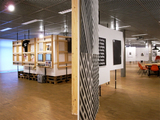Archizoom EPFL
27 Feb – 09 Apr 2009 Lausanne (CH)-
The Services We Offer (Moderated by Sam Jacob)
Thu 12 Mar 18.30 Urs Hofer, Sam Jacob (FAT), Julien Tavelli & David Keshavjee (ecal), Rafael Koch, Jeremy Schorderet (ecal) & Cem Sever (ecal)In 2008, the Swiss pavilion at the Venice Architecture Biennial presented the work of architects Gramazio & Kohler. The project took the form of a robotic arm, reminiscent of one you might find on an automobile production line, which was capable of producing architectural forms, complex both in design and execution (in this case, a flowing sculptural wall). The pavilion aimed to emphasise the dynamics of research in the field of technical production and spatial organisation.
In the realm of visual design, the need for such complex machines is less apparent but nonetheless apparent, from the large-scale international standards implemented by Opentype and complex print-on-demand infrastructures, to homemade desktop scripts and ad-hoc machines
New technologies introduce new ways of thinking, as well as the production of new tools and new forms. This idea raised critical questions about the impact of tools in graphic design, from computer-based tools to digital-analogue hybrids, as illustrated in the exhibition by Jürg Lehni. Fundamental questions are emerging about the resulting visual codes and aesthetics, examining the latitude between standardisation and innovation of the visual outcome, and how in fact these modern tools provide a greater scope for idiosyncratic output.
If form follows function, technique, as a concept, can as well. The visual manifestation of a tool can itself become a sign and a means of visual communication. However, it is necessary that these tools be more than just the spectacle of the application itself. The evening we will discuss through examples that it is the scale of a realisation that defines these new tools. Designers are incredibly capable of producing and publishing their own tools of automation which allow for a sort of micro-mass production, reappropriating techniques deployed in the domain of big business and corporations (databases, Just-in-time). Ideas of automation from a social and historical perspective will also be discussed, with Danial Eatock using the work of artist Sol LeWitt as a model for his own.
Nicole Udry
—
David Keshavjee and Julien Tavelli
David Keshavjee and Julien Tavelli first collaborated at ECAL, Lausanne. Here they present a project combining manual and automatic processes in typography, layout and print, resulting in a unique identity achievable only outside the limitation of “traditional” methods. The outcome is a series of posters with a brutal yet simple quality, born of their interest in developing their own design tools independent of graphic design standards. The project begins with work on a program that can automatically generate an entire typeface. From this font, Keshavjee and Tavelli produce woodcut letters, and finally, create a script to design automatic poster layouts.—
Rafael Koch & Urs Hofer
«Encyclopaedizer» is a collaborative dictionary consisting of an Internet platform, an exhibition interface, and a printed lexicon, created by Rafael Koch and Urs Hofer. The core part of the project is an engine that transforms multimedia content from the Internet into dictionary entries. Unlike other search engines, «Encyclopaedizer’s» results are not a selection of links – the engine tries to render a formally correct definition for any term entered, no matter if the definition is right or wrong in its meaning. The website is both knowledge-bot and dictionary. Every term that has been defined by users is stored in a database.Using this database as the input, a generator script which runs every night transforms all available terms into a printable document. The printed lexicon is the analogue counterpart to the digital archive, and it is available as a book on demand – always current and listed in a chronological order.
The project questions processes of editing, designing and publishing, as well as methods of distribution.
—
Jeremy Schorderet and Cem Sever
Jeremy Schorderet and Cem Sever collaborated on “Open Design Service,” a project developed within a semester brief at ECAL, Lausanne. The aim of the project was to test the implications of open source collaborative processes on the creation of a typeface. The combination of strict technological rules and personal interpretation defined the design of the font. The result is a composite bitmap and lineal typeface which suits both screen and print needs. Some tests were then made with a Tobii Eye Tracking machine at EPFL (Ecole Polytechnique Fédérale de Lausanne) to optimise the font readability for on-screen use.
-

